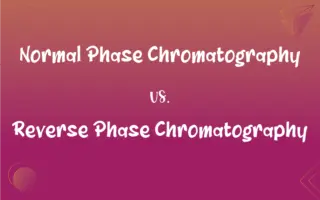Flow Cytometry vs. Immunohistochemistry: What's the Difference?
Edited by Aimie Carlson || By Janet White || Published on May 7, 2024
Flow cytometry analyzes individual cells in suspension using lasers, while immunohistochemistry stains and visualizes specific components in tissue sections.

Key Differences
Flow cytometry is a technique used to detect and measure physical and chemical characteristics of a population of cells or particles. It suspends cells in a stream of fluid and passes them through a laser for analysis. Immunohistochemistry (IHC), on the other hand, involves staining tissue sections to observe the presence and localization of specific proteins or antigens using specific antibodies.
Flow cytometry is known for its ability to analyze multiple parameters of single cells rapidly, often in the thousands to millions of cells per sample. It excels in quantifying protein expression, cell size, and granularity. Immunohistochemistry, conversely, provides detailed visual information about the localization and distribution of proteins within the context of tissue architecture.
A key strength of flow cytometry is its capacity for high-throughput analysis, allowing for the examination of a large number of cells in a relatively short time. However, it lacks spatial context as it doesn't preserve tissue structure. In contrast, immunohistochemistry excels in providing spatial context, showing exactly where proteins are within cells in the tissue, but is not suited for high-throughput analysis.
Flow cytometry requires cells in a liquid suspension and is thus commonly used for blood or dissociated tissue cells. It is highly efficient in cell sorting, based on size, complexity, and fluorescence. Immunohistochemistry requires fixed tissue sections and is extensively used in diagnostic pathology to identify cell types within their native environment.
The data from flow cytometry is quantitative, providing numerical values for the parameters measured, which is ideal for statistical analysis. Immunohistochemistry, while it can be semi-quantitative, primarily provides qualitative data, giving visual insights into tissue and cell morphology.
ADVERTISEMENT
Comparison Chart
Primary Use
Analyzing and sorting individual cells in suspension.
Staining and visualizing specific components in tissue.
Sample Preparation
Requires cells in liquid suspension.
Requires fixed tissue sections.
Data Type
Quantitative (numerical values).
Primarily qualitative (visual data).
Analysis Speed
High-throughput, suitable for large cell populations.
Lower throughput, focused on detailed tissue analysis.
Contextual Information
Limited spatial context due to cell suspension.
Provides spatial context within tissue architecture.
ADVERTISEMENT
Flow Cytometry and Immunohistochemistry Definitions
Flow Cytometry
Involves suspending cells in fluid and passing them through a beam of light for analysis.
Flow cytometry was critical in distinguishing between healthy and cancerous cells.
Immunohistochemistry
Involves the staining of tissue sections to visualize the distribution of proteins.
Through immunohistochemistry, the pathologist could observe the protein localization in the diseased tissue.
Flow Cytometry
It quantifies properties such as cell size, granularity, and protein expression.
The team employed flow cytometry to analyze the expression of different surface markers on immune cells.
Immunohistochemistry
Provides detailed images showing the localization of proteins within tissue cells.
Immunohistochemistry revealed the exact location of the viral infection within the liver tissue.
Flow Cytometry
Often used in immunology and pathology for cell counting and sorting.
Flow cytometry facilitated the sorting of cells based on their fluorescence characteristics.
Immunohistochemistry
A process of selectively identifying antigens in cells of a tissue section using antibodies.
Immunohistochemistry was used to detect the presence of specific cancer markers in the biopsy.
Flow Cytometry
Provides rapid, multi-parametric analysis of thousands to millions of cells.
Flow cytometry enabled researchers to perform a detailed analysis of the cell cycle stages.
Immunohistochemistry
Widely used in clinical diagnostics to identify cell types based on their protein markers.
Immunohistochemistry helped in diagnosing lymphoma by identifying the specific cell types involved.
Flow Cytometry
A technique for counting and analyzing microscopic particles, like cells, using a laser.
Using flow cytometry, the lab was able to rapidly quantify the T-cells in the blood sample.
Immunohistochemistry
Combines anatomical, cellular, and molecular techniques to understand tissue structure and function.
The study utilized immunohistochemistry to investigate the cellular changes in Alzheimer's disease.
Immunohistochemistry
The analytical process of finding proteins in cells of a tissue microtome section exploiting the principle of antibodies binding specifically to antigens in biological tissues.
Immunohistochemistry
An assay that shows specific antigens in tissues by the use of markers that are either fluorescent dyes or enzymes (such as horseradish peroxidase)
FAQs
What is flow cytometry?
A lab technique for analyzing physical and chemical characteristics of cells or particles.
Does flow cytometry provide tissue context?
No, it analyzes cells in suspension, lacking spatial context.
Can flow cytometry sort cells?
Yes, it can sort cells based on size, complexity, and fluorescence.
What does immunohistochemistry do?
Stains and visualizes specific proteins in tissue sections using antibodies.
Is immunohistochemistry quantitative?
Primarily qualitative, but can be semi-quantitative.
What is immunohistochemistry used for in pathology?
Identifying cell types and protein localization in tissue for diagnosis.
How detailed is immunohistochemistry?
Very, providing detailed visualization of protein localization in tissue.
What types of samples are used in flow cytometry?
Blood samples and dissociated tissue cells.
Can immunohistochemistry be automated?
Partially, but it often requires expert interpretation.
Is flow cytometry used in cancer research?
Yes, extensively for analyzing cancer cells and immune responses.
Can flow cytometry analyze solid tissues?
Only after tissue is dissociated into single cells.
Are there limitations to flow cytometry?
It can't provide information about the arrangement of cells in tissues.
What makes flow cytometry fast?
Its ability to analyze thousands of cells per second.
What are common markers used in immunohistochemistry?
Proteins specific to certain cell types, like tumor or immune cells.
How does immunohistochemistry help in cancer diagnosis?
By identifying specific cancer markers in tissue sections.
Can immunohistochemistry show where a protein is within a cell?
Yes, it can show protein distribution within cells and tissues.
How does flow cytometry help in immunology?
By analyzing and sorting immune cells based on their markers.
Does flow cytometry damage cells?
It can, depending on the parameters and handling.
What skills are needed for immunohistochemistry?
Precision in staining techniques and expertise in microscopy.
How long does immunohistochemistry take?
Several hours to a day, depending on the complexity of the staining.
About Author
Written by
Janet WhiteJanet White has been an esteemed writer and blogger for Difference Wiki. Holding a Master's degree in Science and Medical Journalism from the prestigious Boston University, she has consistently demonstrated her expertise and passion for her field. When she's not immersed in her work, Janet relishes her time exercising, delving into a good book, and cherishing moments with friends and family.
Edited by
Aimie CarlsonAimie Carlson, holding a master's degree in English literature, is a fervent English language enthusiast. She lends her writing talents to Difference Wiki, a prominent website that specializes in comparisons, offering readers insightful analyses that both captivate and inform.




































































